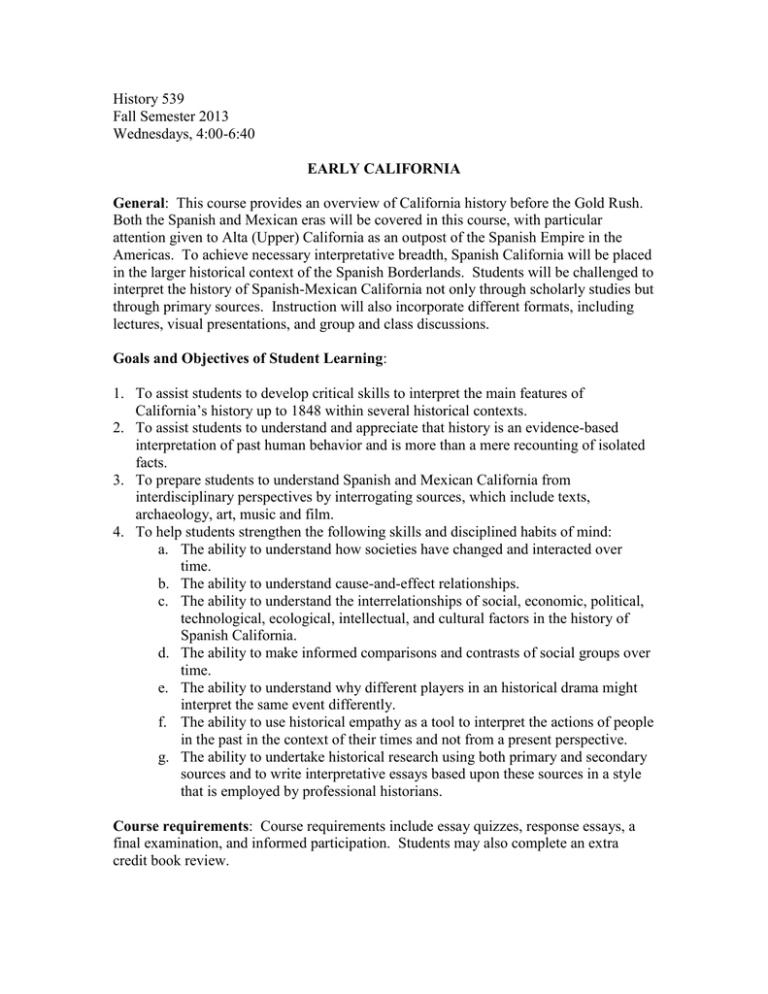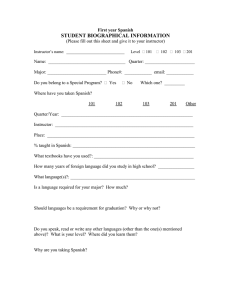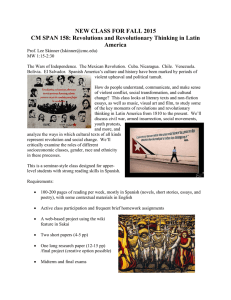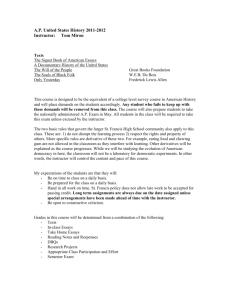History 539 Fall Semester 2013 Wednesdays, 4:00-6:40
advertisement

History 539 Fall Semester 2013 Wednesdays, 4:00-6:40 EARLY CALIFORNIA General: This course provides an overview of California history before the Gold Rush. Both the Spanish and Mexican eras will be covered in this course, with particular attention given to Alta (Upper) California as an outpost of the Spanish Empire in the Americas. To achieve necessary interpretative breadth, Spanish California will be placed in the larger historical context of the Spanish Borderlands. Students will be challenged to interpret the history of Spanish-Mexican California not only through scholarly studies but through primary sources. Instruction will also incorporate different formats, including lectures, visual presentations, and group and class discussions. Goals and Objectives of Student Learning: 1. To assist students to develop critical skills to interpret the main features of California’s history up to 1848 within several historical contexts. 2. To assist students to understand and appreciate that history is an evidence-based interpretation of past human behavior and is more than a mere recounting of isolated facts. 3. To prepare students to understand Spanish and Mexican California from interdisciplinary perspectives by interrogating sources, which include texts, archaeology, art, music and film. 4. To help students strengthen the following skills and disciplined habits of mind: a. The ability to understand how societies have changed and interacted over time. b. The ability to understand cause-and-effect relationships. c. The ability to understand the interrelationships of social, economic, political, technological, ecological, intellectual, and cultural factors in the history of Spanish California. d. The ability to make informed comparisons and contrasts of social groups over time. e. The ability to understand why different players in an historical drama might interpret the same event differently. f. The ability to use historical empathy as a tool to interpret the actions of people in the past in the context of their times and not from a present perspective. g. The ability to undertake historical research using both primary and secondary sources and to write interpretative essays based upon these sources in a style that is employed by professional historians. Course requirements: Course requirements include essay quizzes, response essays, a final examination, and informed participation. Students may also complete an extra credit book review. Quizzes. Unannounced (“spot”) essay quizzes will be given, and these will count toward 30% of the course grade. Each quiz will examine lectures, DVDs, slides, and class discussions from the previous class meeting. Students may drop the lowest scoring quiz. “Make-up” quizzes may be permitted only in cases of documented hardship or illness. Response Essays. Students will write two take-home response essays that will count toward 20% of the course grade. These essays will require students to interpret certain primary sources following detailed guidelines given by the instructor. These essays will be fairly short (around three pages in length), and will be graded “Pass/Fail.” A “Pass” will be assigned to essays earning the equivalent grade of “C” or better (and for graduate students, “B” or better). Students will, then, be called upon not only to utilize their interpretive skills but will also be challenged to express their written interpretations within specified allocations of written space. After the response essays have been submitted to the instructor, a portion of the class period will be devoted to a class discussion centering on, but not necessarily limited to, to the subject of the response essay. “Make-up” response essays may be permitted only in cases of documented hardship or illness. Graduate students are required to write one additional response essay and deliver a brief presentation about this essay to the class (details for this essay will be given by the instructor later in the semester). Final Examination. The final examination will be essay in format, and comprehensive in scope, and will be based upon all required materials. Study guidelines for the final will be distributed during the last class meeting. The final, to be administered on December 18 (4:00-6:00), will count toward 40% of the course grade. Informed Class Participation. Informed class participation will count toward 10% of the course grade. Informed class participation is critical for the success of any class at this level of university instruction. Students are expected to offer insightful comments and questions to the class and to the smaller discussion groups to which they have been assigned. The instructor will maintain a careful record of how a student offers thoughtful, insightful, and evidence-based comments about a particular subject under review. The principal criterion used for evaluating a student’s participation is the frequency a student offers oral commentary in ways that enrich the learning experience of all in the class. Some students may attempt to dominate class discussions or group discussions, or may discuss subjects that are not germane to those under review. These practices will diminish the quality of the learning experiences of others in the class; accordingly, such practices will not be tolerated, and the participation grade of any student who engages in such practices will be negatively affected. Absences that are not authorized (that is, for reasons other than documented illness or hardship) will negatively affect the grade assigned to the participation component of this course. A student’s participation grade will be derived from a “curve” that will be developed by comparing her/his performance as a participant with that of other students in the class. 2 An “extra credit” book review, not to exceed three double-spaced, machine-produced pages, will count toward a maximum of an additional 4 points toward to the course grade. Only papers earning the grade of “B” or better will be counted: “B”=3 points and “A”= 4 points. Each student will have the opportunity of selecting a book of his/her choice for this review, but the selection must have the approval of the instructor. Students are, then, required to submit to the instructor a formal written request giving the author, title, and publisher of the book intended for review. The review must be of a scholarly secondary work, not a primary source, treating some aspect of the history of Spanish and/or Mexican California. The review is not a summary of a book’s contents, but rather must be a critical assessment of the following features of authorship: 1) writing style; 2) organization; 3) interpretation; 4) the nature, quality, and use of sources; and 5) originality. The book reviews are due at the beginning of the class on December 11; reviews may be turned in before that date but no late reviews will be accepted. Moreover, reviews that contain more than three spelling errors, three contractions, or three incomplete sentences, will not be accepted. Reading assignments: The four required books that are to be purchased for this course are: Beebe, Rose Marie and Robert M. Senkewicz, eds. Lands of Promise and Despair: Chronicles of Early California, 1535-1846. Santa Clara and Berkeley: Santa Clara University and Heyday Books, 2001. La Pérouse, Jean François De. Monterey in 1786: Life in a California Mission. Berkeley: Heyday Books, 1989. Sandos, James A. Converting California: Indians and Franciscans in the Missions. New Haven and London: Yale University Press, 2004. Weber, David J. The Spanish Frontier in North America, Brief Edition. New Haven and London: Yale University Press, 2009. The six required articles from The Journal of San Diego History (access this journal online via Google by the title of the journal, click on Index to The Journal of San Diego History, and then scroll to the issues in which the articles appear]): Cutter, Donald C. “Plans for the Occupation of Upper California: A New Look at the ‘Dark Age’ from 1602 to 1769.” JSDH 24, no. 1 (Winter 1978). Ezell, Paul. “The Excavation Program at the San Diego Presidio.” JSDH 22, no. 4 (Fall 1976). 3 Galbraith, Craig S., Curt H. Stiles, and Jacqueline Benitez-Galbraith, “Economics and Spirituality in the Entrepreneurial Development Strategy of the Franciscan California Missions: The Historical Case of San Diego,” JSDH 56, no. 4 (Fall 2010). Griswold del Castillo, Richard. “The U.S.-Mexican War in San Diego, 18461847: Loyalty and Resistance.” JSDH 49, no. 1 (Winter 2003). Mason, Bill. “The Garrisons of San Diego Presidio: 1770-1794.” JSDH 24, no. 4 (Fall 1978). Mathes, W. Michael. “The Discoverer of Alta California: João Rodriguez Cabrilho or Juan Rodríguez Cabrillo?” JSDH 19, no. 3 (Summer 1973). Nine other required readings are available as electronic resources through the SDSU PAC (access these by the titles of the book and journal): Bolton, Herbert Eugene. The Spanish Borderlands: A Chronicle of Old Florida and the Southwest; introduction by Albert L. Hurtado. Albuquerque: University of New Mexico Press, 1996. This is an Electronic Book (E-Book), and Hurtado’s introduction is required. Hurtado’s introduction is also available on Course Documents (via Blackboard) as a PDF. Castañeda, Antonia I. “Engendering the History of Alta California, 1769-1848: Gender, Sexuality, and the Family,” California History 76, no. 2/3 (Summer/Fall, 1997): 230-59. Castañeda, Antonia. “Hispanas and Hispanos in a Mestizo Society.” OAH Magazine of History 14 (Summer 2000). Engstrand, Iris H.W. “How Cruel Were the Spaniards?” OAH Magazine of History 14, Issue 4 (Summer 2000). Guerrero, Vladmir. “Caste, Race, and Class in Spanish California,” Southern California Quarterly [SCQ] 92, no. 1 (Spring 2010): 1-18. Hurtado, L. Albert. “Bolton and Turner: The Borderlands and American Exceptionalism.” The Western Historical Quarterly [WHQ] 44, no. 1 (Spring 2013): 4-20. Lothrop, Gloria Ricci. “Life in Presidial California.” OAH Magazine of History 14, Issue 4 (Summer 2000). Simmons, William S. Simmons. “Indian Peoples of California,” California History 76, no. 2/3 (Summer/Fall 1997): 48-77. 4 Weber, David J. “The Spanish Borderlands of North America: A Historiography.” OAH Magazine of History 14, Issue 4 (Summer 2000). All required reading assignments are given below in the Course Outline. Students may begin the assigned readings at any time, of course, but they should be aware that the readings that appear for a given week are to be completed before class is held that week, and lectures will be given and class discussions will be directed with this premise in mind. Because the lengths of these readings vary weekly, students should plan their study schedules accordingly. Grading Criteria: A student’s course grade will be based on the total number of points that he/she has earned during the semester. For example, a student who has received an average of 80% on the quizzes will have earned 24 points out of a maximum of 30 points for that category of required work. The final examination will be computed in the same manner. Because the response essays are pass/fail, each of the two essays that receives a “pass” counts as 10 points toward the course grade (or for graduate students, each of the four essays that receives a “pass” counts as 5 points toward the course grade). Extra credit book reviews may count up to an additional 3 or 4 points. Participation grades are weighted as: “A” (10 points), “B” (8 points), “C” (7 points), “D” (6 points), and “F” (0 points). All of the work that a student completes will be calculated in this manner to yield a total number of points, which will in turn be correlated to the following letter grades for the course: “A” (90-100 points), “A-“ (89 points), “B+” (88 points), “B” (8087 points), “B-“ (79 points), “C+” (78 points), “C” (70-77 points), “C-“ (69 points), “D+” (68 points), “D” (60-67 points), “D-“ (59 points), “F” (58 points and below). Classroom Protocol: A classroom should provide an environment that fosters the assimilation of knowledge and the responsible and civilized exchange of ideas. Most students attend a class because they genuinely wish to learn a particular subject. However, some students will enroll in courses who do not have this seriousness of purpose, and a few of these individuals will occasionally engage in disruptive classroom behavior. Such behavior includes talking during lectures and video presentations, interrupting the instructor during his/her lecture, and arriving late and/or leaving early without previously notifying the instructor of compelling reasons for entering or exiting the classroom while class is in session. Of course, disruptiveness of any kind is disturbing to instructors and serious students alike. Accordingly, any form of behavior deemed by the instructor to be disruptive will not be tolerated. The instructor will advise a student once that his/her behavior is disruptive; the first time this disruptive behavior is repeated, the matter will be turned over to the Center for Students Rights and Responsibilities for appropriate review. Academic integrity is a foundational principle of this course. Academic integrity is violated by such acts as borrowing or purchasing written works (including works obtained over the Internet) and presenting these works as one’s own, and using concealed notes during examinations. The sources of one’s ideas, words, and evidence must be fully cited; failure to do so, intentionally or not, constitutes plagiarism. Any evidence of violations of academic integrity by a student will result in an automatic “F” as that 5 student’s course grade. Moreover, any evidence of such violations will also be promptly reported to the Center for Students Rights and Responsibilities. All cell phones, pagers, and text-messaging devices must be turned off during the class period. No essays or extra credit book reviews submitted electronically will be accepted. Students are expected to adhere to the “acceptable standards for conduct” as described on the web page of the SDSU Center for Students Rights and Responsibilities (http://www.sdsu.edu/ssr/). Students are held responsible for all material covered in class (lectures, discussions, slides, and DVDs) even if they are not attendance for whatever reason. Changes to Assignments: Note that due dates, readings, and the criteria necessary for completing assignments may change during the semester. You are responsible for any and all changes announced in class, even if you are not present. If you need to call me about missed announcements, please do so during my office hours. Instructor: S.A. Colston. Office: Arts & Letters, Room 528. Telephone: 594-4716 (voice mail). Email: colston@mail.sdsu.edu Office Hours: Mondays, Tuesdays, and Wednesdays, 1:30-2:30. The instructor will return E-mail and voice mail messages only during regular office hours. COURSE OUTLINE Weekly Topics and Assignments 1 (August 28) Introduction to Course. Geography. Sources for the History of Spanish and Mexican California. 2 (September 4) Historians of the Spanish Borderlands and Spanish-Mexican California. Reading assignment: Weber, Introduction; Bolton (required is Hurtado’s introduction in this E-Book or as a course document PDF); Hurtado (WHQ electronic); Weber (OAH electronic); Lands of Promise (“Introduction”). 3 (September 11) Native Culture History of California. Reading assignment: Sandos, Chapter 1; Simmons. 4 (September 18) Spain’s New World. Reading assignment: Weber, Chapter 1. Lands of Promise (1492:Columbus; 1510:Rodríguez de Montalvo;1513:Las Casas; 1514:Requerimiento;1519:Bernal Díaz del Castillo). 6 5 (September 25) The Colonial Spanish Borderlands through the Pueblo Revolt of 1680. Reading assignment: Weber, Chapters 2-5. 6 (October 2) The Colonial Spanish Borderlands after the Pueblo Revolt. The Evolution of Borderlands Society and Culture. Reading assignment: Weber, Chapters 6-8, 11. Lands of Promise (1697:Salvatierra; 1744:Balthasar; 1744:Sistiaga; 1760s:Barco). 7 (October 9) Early Spanish Voyages to California. Reading assignment: Mathes (JSDH electronic); Lands of Promise (1525:Cortés; 1542:Cabrillo; 16021603:Vizcaíno; 1620:Ascención; “California as an Island”). 8 (October 16) Spain’s Motives for Occupying California. Occupation and Early Settlement. Reading assignment: Weber, Chapter 9; Cutter (JSDH electronic); Lands of Promise (1768:Gálvez; 1769:Costansó; 1769:Crespí; 1769:Portolá; 1770:Serra; 1771:Palóu; 1772:Verger, Iriarte, and Palóu; 1776:Font; 1776:Palóu). 9 (October 23) State and Church in Spanish California. Reading assignment: Lands of Promise (1772:Jayme; 1773:Fages; 1773:Serra; 1775:Fuster; 1776:Palóu; 1779:Neve; 1782:Neve; 1785:Velásquez; 1785:Toypurina; 1796:Goycoechea; 1797:Argüello); Sandos, Chapters 1-6, 8-10. 10 (October 30) The Church (continued). Economic and Social Life in Spanish California. Reading assignment: review Weber, Chapter 11; Galbraith/Stiles/Benitez-Galbraith (JSDH electronic); Guerrero (SCQ electronic); Lands of Promise (1785:Callis; 1809:Arrillaga and Estudillo; 1819:Alvarado); Castañeda (OAH electronic); Ezell, Krase, and Mason (all from JSDH electronic); Lothrop (OAH electronic). 11 (November 6) Textual Images by “Outsiders” of Late Eighteenth-Century California. Reading assignment: La Pérouse (all). 12 (November 13) Russian California. Mexican California: Church and State. Reading assignment: Lands of Promise (1824:Gonzáles; 1820s:Pablo Tac; 1827:Pío Pico; 1827:Virmond; 1829:Robinson; 1829:Sánchez and Piña; 7 1830:Bandini; 1831:Carrillo; 1833:Estudillo, et al; 1835:Anzar and Castro; Sandos, Chapter 7 and review Chapter 10. 13 (November 20) Mexican California: Economic and Social Life. Reading assignment: 1824:Osio; 1825:Rojo and de la Guerra; 1827:Pico; 1828:Argüello; 1831:Carrillo; 1835:Janssens; 1837:Castillero; 1837:Machado; 1841:Vallejo; 1842:Alvarado; 1840s:Lugo; 1840s:Coronel; Retrospective:César). 14 (November 27) The World of the Mission in Spanish-Mexican California. Exploring Controversies about the Mission System. Reading assignment: Bushnell and Engstrand (both OAH electronic); Sandos, Chapter 11 and review all other chapters; review Galbraith/Stiles/Benitez-Galbraith (JSDH electronic). 15 (December 4) U.S.-Mexico War. Treaty of Guadalupe Hidalgo. Reading assignment: Griswold del Castillo (JSDH electronic); Lands of Promise (1842:Jones and Osio). 16 (December 11) Conclusions to Course. Review for Final Examination. Extra Credit Book Reviews Due at 4:00. 8



